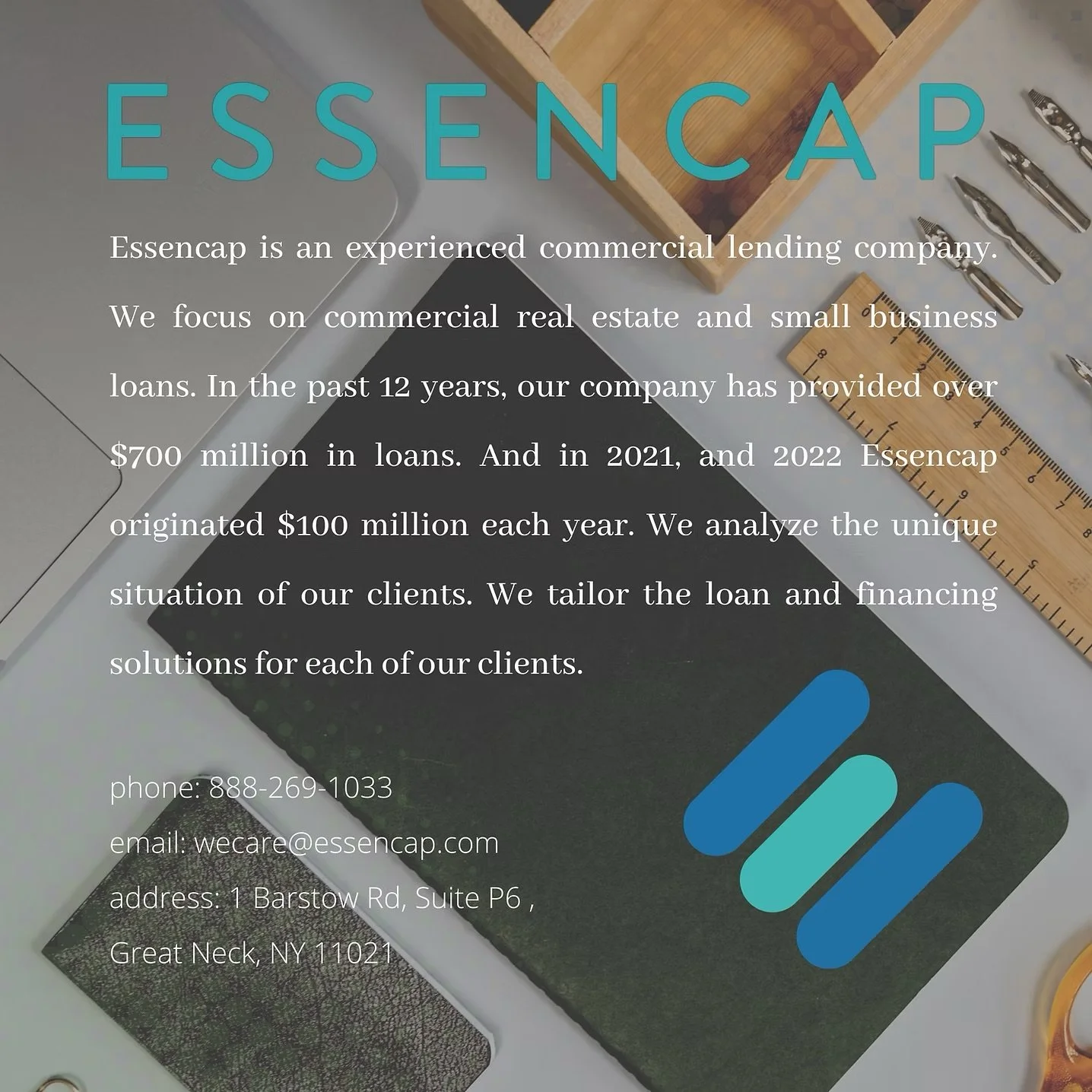Understanding DSCR Loans: Traditional vs. Streamlined Approaches
A Comprehensive Guide from Essencap Funding
At Essencap Funding, as a DSCR lenders in the market, we understand that choosing the right financing approach is crucial for your investment success. Having originated countless DSCR loans across different property types and loan sizes, we want to share our expertise on the two primary underwriting methodologies available to today's real estate investors.
The Debt Service Coverage Ratio (DSCR) serves as the cornerstone metric for evaluating a property's ability to service its debt obligations. However, not all DSCR calculations are created equal. Different property types, loan amounts, and investor needs require tailored approaches to achieve optimal financing outcomes.
Traditional Commercial DSCR: The Comprehensive Approach
For substantial commercial transactions—including office buildings, industrial facilities, retail centers, multifamily complexes, build-to-rent communities, and large single-family rental portfolios—traditional lenders employ this time-tested formula:
DSCR = Net Operating Income (NOI) ÷ Annual Debt Service
Where:
Net Operating Income (NOI)
= Gross rental income minus all operating expenses (excluding debt service)
Annual Debt Service
= Total annual principal and interest payments
Example Calculation:
NOI: $1,200,000
Annual Debt Service: $1,000,000
DSCR: $1,200,000 ÷ $1,000,000 = 1.20
This 1.20 DSCR indicates the property generates 20% more income than required for debt payments, providing a healthy cushion for lenders and borrowers alike.
Key Underwriting Standards
Minimum DSCR requirements typically range from 1.20 to 1.40, depending on property type, market conditions, and lender risk appetite
NOI undergoes comprehensive analysis to ensure sustainable, realistic cash flow projections
Revenue Adjustments in Traditional Underwriting
Traditional commercial underwriting goes beyond surface-level rent rolls, incorporating these critical adjustments:
Vacancy Loss
: Market-based allowance (typically 5-10%) for potential vacant units
Collection Loss
: Provisions for late or uncollected rents
Concessions and Free Rent
: Discounts offered to attract or retain tenants
Income Normalization
: Exclusion of non-recurring or speculative revenue sources
Operating Expense Considerations
Lenders evaluate true operating costs by including:
Property Management
: Even for self-managed properties (typically 4-6% of effective gross income)
Maintenance and Repairs
: Routine property upkeep (excluding capital improvements)
Utilities
: Owner-paid water, sewer, electricity for common areas
Insurance
: Comprehensive hazard and liability coverage
Real Estate Taxes
: Including projected reassessments
Replacement Reserves
: Capital expenditure reserves for major systems
Administrative Costs
: Accounting, legal, and office expenses
Janitorial Services
: Common area and commercial space cleaning
Ground Lease Payments
: When applicable
Turnover Expenses
: Unit preparation and leasing costs
Contracted Services
: Landscaping, pest control, waste management, security
This thorough approach ensures lenders evaluate genuine, sustainable cash flow rather than optimistic projections.
Streamlined DSCR: Efficiency for Smaller Investments
For smaller-balance loans, Essencap Funding and many private lenders utilize a streamlined DSCR approach that prioritizes efficiency without compromising lending standards.
This methodology is particularly well-suited for:
Single-family rental properties
1-4 unit investment properties
Small multifamily buildings (5-10 units)
Smaller mixed-use properties
SFR portfolio loans under approximately $3 million
Rather than requiring detailed operating statements, this approach focuses on the fundamental relationship between rental income and essential carrying costs:
DSCR = Gross Rental Income ÷ P.I.T.A.
Where:
Gross Rental Income
: Monthly rents annualized for consistency
P.I.T.A.
: Principal, Interest, Taxes, and Insurance (annual basis)
Example Calculation:
Annualized Rental Income: $30,000
P.I.T.A.: $24,000
DSCR: $30,000 ÷ $24,000 = 1.25
Advantages of Streamlined DSCR
Accelerated Processing
: Faster, simplified underwriting ideal for active investors
Market-Based Analysis
: Uses current market rents or existing leases without extensive documentation
Flexible Qualification
: Often allows minimum DSCRs as low as 1.0, typically enabling higher loan proceeds
Hybrid Options
: For SFR portfolios in the $2-3 million range, borrowers may choose between streamlined or traditional underwriting based on their documentation and preferences
Understanding Recourse vs. Non-Recourse Structure
A critical distinction between these DSCR approaches lies in the recourse structure:
Traditional Commercial DSCR Loans are typically non-recourse, meaning:
Borrower liability is limited to the property itself
In case of default, lenders can foreclose on the property but generally cannot pursue personal assets
Exceptions exist for "bad boy" carve-outs (fraud, environmental violations, etc.)
Lenders rely primarily on property cash flow for loan repayment
Streamlined DSCR Loans are typically recourse, meaning:
Borrowers provide personal guarantees
Lenders can pursue personal assets if property cash flow is insufficient
Combined reliance on both property performance and personal guarantees
Often enables more favorable loan terms due to enhanced security
Strategic Implications for Real Estate Investors
Loan Amount Considerations
Non-Recourse Loans
: Generally structured for larger amounts (typically over $3 million) on substantial commercial properties
Recourse Loans
: Common for smaller amounts (often under $3 million) on residential investment properties
Loan Proceeds Optimization
Streamlined Approach
: Often delivers higher loan-to-value ratios due to simplified underwriting and personal guarantees
Traditional Approach
: May result in slightly lower proceeds due to comprehensive expense analysis and reserve requirements
Best Practices for Success
At Essencap Funding, we recommend that investors:
Analyze Cash Flow Under Both Methods
: Understand how your property performs under different underwriting scenarios
Consider Market Conditions
: Factor in realistic vacancy rates and operating expenses, regardless of the lender's underwriting approach
Evaluate Risk Tolerance
: Carefully weigh the implications of recourse vs. non-recourse structures
Plan for Contingencies
: Always budget for vacancies, repairs, and unexpected expenses
Work with Experienced Partners
: Choose lenders who understand your investment strategy and can provide appropriate financing solutions
Why This Matters
Understanding these fundamental differences empowers real estate investors and mortgage brokers to make informed decisions about financing structures, risk management, and deal optimization. Whether you're acquiring a single-family rental or a large commercial property, the right DSCR approach can significantly impact your investment returns and long-term success.
At Essencap Funding, we're committed to providing flexible, efficient financing solutions that align with your investment objectives. Our expertise in both traditional and streamlined DSCR lending enables us to structure the optimal financing for your specific needs.


